#June 12 1898
Text

"We do hereby proclaim and declare solemnly in the name by authority of the people of these Philippine Islands, that they are, and have, the right to be free and independent; that they have ceased to have allegiance to the Crown of Spain; that all political ties between them should be completely severed and annulled; and that, like other free and independent States, they should enjoy the full power to make War and Peace, conclude commercial treaties, enter into alliances, regulate commerce, and do all other acts and things which and Independent State has right to do, and imbued with firm confidence in Divine Providence, we hereby mutually bind ourselves to support this Declaration with our lives, our fortunes, and with our sacred possession, our Honor."
- Act of Declaration of Philippine Independence
On June 12, 1898, the Philippine Revolutionary Government declared independence from the Spanish Crown during a ceremony held at the home of Revolutionary President, General Emilio Aguinaldo.
Bayang magiliw
Perlas ng silanganan
Alab ng puso sa dibdib mo'y buhay
Lupang Hinirang, duyan ka ng magiting
Sa manlulupig, di ka pasisiil...
Translation:
Beloved country
Pearl of the east
Flame of the heart alive in your chest
Chosen land, cradle of the brave
From conquerors, you will not be crushed...
- Philippine National Anthem -
Featuring:
Kayla - @techbro-arts
#Silver Wing#Kayla#techbro-arts#Art#Random Art#MLP#My Little Pony#Pegasus#Earth Pony#History#Philippine History#Philippine Independence#Independence Day#June 12#June 12 1898
14 notes
·
View notes
Text
Happy Independence Day!

This is me holding the Philippine flag and wearing an ensemble called baro't saya (literally blouse and skirt) based on items I actually own. The background is a photograph I took of a beach in Caramoan, off the coast of the Bicol peninsula.

On June 12, 1898, the Philippine national flag was revealed for the first time and accompanied by the melody of what would become the national anthem.
youtube
#philippine independence day#June 12 1898#lupang hinirang#self portrait#face reveal#not really#but close enough#digital art#medibangpaint#medibang art#medibang paint#artstreet medibang#medibang#philippine revolution#philippine american war#philippine history#philippine culture#baro't saya#Philippine national anthem#Philippine flag#Youtube#aeshna's art#araw ng kasarinlan
10 notes
·
View notes
Text

Le Petit écho de la mode, vol. 20, no. 24, 12 juin 1898, Paris. Sautoir Lakmé. Garniture de ceinture. 1. Toilette de promenade. Ville de Paris / Bibliothèque Forney
Sautoir Lakmé. Après le succès obtenu par notre sautoir Sapho et les nombreux compliments que nous recevons de toutes parts pour cette gracieuse parure, nous continuons à offrir à nos aimables lectrices les nouveautés que la Mode édite en ce genre. Voici un vrai bijou pour les jeunes filles: c’est un sautoir fait d’une seule ganse de soie noire et de motifs en perles turquoise entourés de perles d’acier qui sert à retenir une montre, un crayon, etc. Ce délicieux sautoir est offert au prix minime de 1 fr. 65 franco.
Dans un autre ordre d’idées, voici une parure de robes qui, jusqu’à présent, n’était pas abordable à toutes les bourses, vu sa qualité supérieure et sa suprême élégance. Nous avons, dans ce cas, traité avec une des premières maisons de Paris, et nous sommes heureux d’offrir, au prix de 3 fr.75 franco, une joli parure de ceinture en véritable acier fin composé de: une agrafe (dont notre gravure ne donne qu’un faible aperçu) et trois boucles que l’on coule derrière et sur les côtés sur une ceinture droite en ruban de velours ou défaille. Un délai de 8 jours nous est nécessaire pour la bonne exécution des commandes.
Robe en batiste, guipure de Gênes et satin. La jupe, coupée d une seule pièce, est garnie dans le bas de trois entre-deux poses à clair laissant voir le transparent du fond de jupe. Le corsage, gracieusement drapé à gauche sous un bijou de strass, est garni d entre-deux, le haut décolleté sur un empiècement de guipure posé sur un transparent; dos tendu, col droit et ruche, tour de taille en ruban fermé par une boucle en acier, manche garnie d’un volant de dentelle. Toquet en paille garni d'ailes et de tulle, bijou de strass.
—
Lakmé necklace. After the success obtained by our Sapho necklace and the numerous compliments that we received for this graceful adornment, we continue to offer our kind readers the new fashions in this style. Here is a real piece of jewelry for young girls: it is a necklace made of a single black silk braid and turquoise bead patterns surrounded by steel beads which is used to hold a watch, a pencil, etc. This delicious sautoir is offered at the low price of 1.65 francs.
On another note, here is a set of accessories which, until now, was not affordable for all budgets, given its superior quality and supreme elegance. In this case, we have dealt with one of the leading houses in Paris, and we are happy to offer, at the price of 3.75 francs, a pretty belt set in real fine steel composed of: a clasp (including our engraving gives only a faint glimpse) and three loops that run behind and on the sides on a straight belt of velvet ribbon or faille.
Dress in cambric, Genoa guipure and satin. The skirt, cut in one piece, is trimmed at the bottom with three light inserts revealing the transparency of the skirt bottom. The bodice, gracefully draped on the left under a rhinestone jewel, is garnished with insets, the high neckline on a guipure yoke placed on a transparent; stretched back, straight collar and ruffle, ribbon waistline closed with a steel buckle, sleeve trimmed with a lace ruffle. Straw toquet garnished with wings and tulle, rhinestone jewel.
Matériaux: 12 métrés de batiste, 15 mètres d’entre-deux, 0m35 de guipure et de satin blanc, 4 mètres de ruban.
#Le Petit écho de la mode#19th century#1890s#1898#on this day#June 12#periodical#fashion#fashion plate#cover#color#description#Forney#dress#parasol#necklace#collar
20 notes
·
View notes
Text
I'm not as well versed in the Philippines' history since I read this a long time ago, but the Philippines were taken from Spain as colonies after the US war with Spain in 1898. At the time, the Filipinos were already waging their own independence war against Spain. The Filipinos declared the First Philippine Republic in June 12 1899. However, the United States refused to accept it, which led to a bloody independence war that lasted decades, where the US military commited genocidal acts:
After World War II and the end of Japanese occupation, because of the obvious drag of holding a colonial possession of millions of people across the Pacific* during an era of decolonization, the US eventually "gave" the Philippines their independence in 1946 after World War II. The fact that they choose the 4th of July was not casual at all: they very much tried to imprint themselves, the former colonial power, as the gentle benefactors of a "daughter republic". There are INCREDIBLY racist cartoons of the US setting itself up as a "teacher" to its conquered nations, "preparing" them for self-determination.
This was a common practice by the US. I've read this in depth a long time ago and I'm sure you can find this in better detail elsewhere, but as the US was rising as an imperial power, it presented itself as an "Empire of Freedom", in suppossed contrast to the European powers, at the same time it did the same, if not worse (as shown in the Philipines) exploitation and crimes across the Pacific and Latin America. If they had could, they would have extended an entire plantation economy all around the Caribbean. Countless interventions testify this.
Of course the Philippines became independent, but it wasn't out of the benvolence of the United States. The US was perfectly willing and able to annex places on the Pacific. Of course you know about Hawai'i and Puerto Rico, which centuries after, still does not have self-determination. But how many Usamericans know about the "associated states" of Palau, Micronesia and the Marshall Islands, of the military bases at Guam? And let alone the countless genocides in the continental US in the name of manifest destiny.
Anyways. My point is, if you saw a post claiming the Philippines' independence was in the 4th of July, maybe you should have asked yourself why, exactly.
133 notes
·
View notes
Text

Wallace Ford (February 12, 1898 – June 11, 1966)
13 notes
·
View notes
Text
This day in history

NEXT WEEKEND (June 7–9), I'm in AMHERST, NEW YORK to keynote the 25th Annual Media Ecology Association Convention and accept the Neil Postman Award for Career Achievement in Public Intellectual Activity.

#20yrsago Bradbury goes nuts over Fahrenheit 9/11 title https://web.archive.org/web/20051219090823/https://www.wnd.com/news/article.asp?ARTICLE_ID=38776
#15yrsago Ryanair serious about charging to use toilets in-flight, may charge extra “breathing fee” for inhaling during flight https://www.theguardian.com/business/2009/jun/02/ryanair-airline-oleary-toilet-charge
#15yrsago Jo Walton on THE SPACE MERCHANTS https://web.archive.org/web/20090612060824/http://www.tor.com/index.php
#15yrsago Roald Dahl on vaccinating your kids https://web.archive.org/web/20090606123639/http://www.childalert.co.uk/absolutenm/templates/newstemplate.asp?articleid=291&zoneid=2
#15yrsago Canadian copyright lobbyists leaned on “independent” researchers to change report on file-sharing https://web.archive.org/web/20090605230056/http://www.michaelgeist.ca/content/view/4025/125/
#10yrsago Russia’s army of paid astroturfers message-bomb western coverage of Ukraine https://www.buzzfeednews.com/article/maxseddon/documents-show-how-russias-troll-army-hit-america
#10yrsago A scarf woven from Jay Lake’s genome https://fishwrapper.wordpress.com/2013/08/12/jays-genome-project-part-3/
#10yrsago Riis’s “How the Other Half Lives”: photos of NYC slumlife in the Gilded Age https://web.archive.org/web/20140625121238/http://www.authentichistory.com/1898-1913/2-progressivism/2-riis/index.html
#10yrsago The more your job helps people, the less you’re paid (and vice-versa) https://www.salon.com/2014/06/01/help_us_thomas_piketty_the_1s_sick_and_twisted_new_scheme/
#10yrsago It’s not Net Neutrality that’s at stake, it’s Cable Company Fuckery https://www.youtube.com/watch?v=fpbOEoRrHyU
#10yrsago Critical thinking vs education: Teaching kids math without “correct” answers https://powersfulmath.wordpress.com/2014/04/30/who-or-what-broke-my-kids/
#10yrsago Piketty’s methods: parsing wealth inequality data and its critique https://www.washingtonpost.com/news/wonk/wp/2014/05/30/pikettys-errors-arent-mistakes-theyre-questions-and-he-answered-them/
#5yrsago That woman who got fired for comparing Michelle Obama to an ape is now going to jail for defrauding FEMA https://www.nbcnews.com/news/us-news/woman-who-called-michelle-obama-ape-sentenced-jail-defrauding-fema-n1012936
#5yrsago The army of contractor-linguists who power Google Assistant say they had their wages stolen https://www.theguardian.com/technology/2019/may/28/a-white-collar-sweatshop-google-assistant-contractors-allege-wage-theft
#5yrsago Rumor: DoJ is going to investigate Google for antitrust violations https://www.cnbc.com/2019/05/31/doj-preparing-antitrust-probe-of-google---dow-jones.html
#5yrsago Stop saying “robots are coming for your job”; start saying “Your boss wants to replace you with a robot” https://gizmodo.com/robots-are-not-coming-for-your-job-management-is-1835127820
#5yrsago Ted Chiang’s “Op Ed From the Future”: socialized transhumanism vs American oligarchy https://www.nytimes.com/2019/05/27/opinion/ted-chiang-future-genetic-engineering.html
#5yrsago Report from the Fed reveals that “economic growth” is a highly localized phenomena, masking widespread financial desperation https://www.nakedcapitalism.com/2019/06/st-louis-fed-study-shows-rising-level-of-financial-desperation-among-the-poor-hidden-by-aggregates.html
#5yrsago All weekend, California Democrats booed neoliberal would-be presidents who talked down the Green New Deal and Medicare for All https://memex.craphound.com/2019/06/03/all-weekend-california-democrats-booed-neoliberal-would-be-presidents-who-talked-down-the-green-new-deal-and-medicare-for-all/
#5yrsago Speech Police: vital, critical look at the drive to force Big Tech to control who may speak and what they may say https://memex.craphound.com/2019/06/03/speech-police-vital-critical-look-at-the-drive-to-force-big-tech-to-control-who-may-speak-and-what-they-may-say/
#1yrago Washington State's capital gains tax proves we can have nice things https://pluralistic.net/2023/06/03/when-the-tide-goes-out/#passive-income
8 notes
·
View notes
Text
·˚ ༘₊· ͟͟͞͞꒰➳ fun fact of the day!
our fun fact for today originates from the philippines, since i feel like appreciating my country's history today :)
✧─── ・ 。゚★: .✦ . :★. ───✧
the day that the americans declared the philippine's independence from japan and america itself lines up with america's own independence day, july 4th. however, because of these dates lining up, the filipino people did notice, and changed the date to june 12, when we declared our own independence from spain in 1898!
✧─── ・ 。゚★: .✦ . :★. ───✧
4 notes
·
View notes
Text
Today the Church remembers the 108 Blessed Polish Martyrs.
Orate pro nobis.
The 108 Blessed Polish Martyrs were Roman Catholic Christians in Poland killed during World War II by the Nazis, either in the concentration camps or by mass slaughter on the streets. The group comprises 3 bishops, 79 priests, 7 male religious, 8 female religious, and 11 lay people. There are two parishes named for the 108 Martyrs of World War II in Powiercie in Koło County, and in Malbork, Poland.
The 108 Blessed Martyrs were beatified on 13 June 1999 by Pope John Paul II in Warsaw, Poland.
List of Martyrs
Bishops
1. Antoni Julian Nowowiejski (1858–1941 KL Soldau), bishop
2. Leon Wetmański (1886–1941 KL Soldau), bishop
3. Władysław Goral (1898–1945 KL Sachsenhausen), bishop
Priests
1. Adam Bargielski, priest from Myszyniec (1903–1942 KZ Dachau)
2. Aleksy Sobaszek, priest (1895–1942 KL Dachau)
3. Alfons Maria Mazurek, Carmelite friar, prior, priest (1891–1944, shot by the Gestapo)
4. Alojzy Liguda, Society of the Divine Word, priest (1898–1942 KL Dachau)
5. Anastazy Jakub Pankiewicz, Franciscan friar, priest (1882–1942 KL Dachau)
6. Anicet Kopliński, Capuchin friar, priest in Warsaw (1875–1941)
7. Antoni Beszta-Borowski, priest, dean of Bielsk Podlaski (1880–1943, shot near Bielsk Podlaski)
8. Antoni Leszczewicz, Marian Father, priest (1890–1943, burnt to death in Rosica, Belarus)
9. Antoni Rewera, priest, dean of the Cathedral Chapter in Sandomierz (1869–1942 KL Dachau)
10. Antoni Świadek, priest from Bydgoszcz (1909–1945 KL Dachau)
11. Antoni Zawistowski, priest (1882–1942 KL Dachau)
12. Bolesław Strzelecki, priest (1896–1941 KL Auschwitz)
13. Bronisław Komorowski, priest (1889–22 March 1940 KL Stutthof)
14. Dominik Jędrzejewski, priest (1886–1942 KL Dachau)
15. Edward Detkens, priest (1885–1942 KL Dachau)
16. Edward Grzymała, priest (1906–1942 KL Dachau)
17. Emil Szramek, priest (1887–1942 KL Dachau)
18. Fidelis Chojnacki, Capuchin friar, priest (1906–1942, KL Dachau)
19. Florian Stępniak, Capuchin friar, priest (1912–1942 KL Dachau)
20. Franciszek Dachtera, priest (1910–23 August 1942 KL Dachau)
21. Franciszek Drzewiecki, Orionine Father, priest (1908–1942 KL Dachau); from Zduny, he was condemned to heavy work in the plantation of Dachau. While he was bending over tilling the soil, he adored the consecrated hosts kept in a small box in front of him. While he was going to the gas chamber, he encouraged his companions, saying "We offer our life for God, for the Church and for our Country".
22. Franciszek Rogaczewski, priest from Gdańsk (1892–1940, shot in Stutthof or in Piaśnica, Pomerania)
23. Franciszek Rosłaniec, priest (1889–1942 KL Dachau)
24. Henryk Hlebowicz, priest (1904–1941, shot at Borisov in Belarus)
25. Henryk Kaczorowski, priest from Włocławek (1888–1942)
26. Henryk Krzysztofik, religious priest (1908–1942 KL Dachau)
27. Hilary Paweł Januszewski, religious priest (1907–1945 KL Dachau)
28. Jan Antonin Bajewski, Conventual Franciscan friar, priest (1915–1941 KL Auschwitz); of Niepokalanow. These were the closest collaborators of St Maximilian Kolbe in the fight for God's cause and together suffered and helped each other spiritually in their offering their lives at Auschwitz
29. Jan Franciszek Czartoryski, Dominican friar, priest (1897–1944)
30. Jan Nepomucen Chrzan, priest (1885–1942 KL Dachau)
31. Jerzy Kaszyra, Marian Father, priest (1910–1943, burnt to death in Rosica, Belarus)
32. Józef Achilles Puchała, Franciscan friar, priest (1911–1943, killed near Iwieniec, Belarus)
33. Józef Cebula, Missionary Oblate, priest (23 March 1902 – 9 May 1941 KL Mauthausen)[
34. Józef Czempiel, priest (1883–1942 KL Mauthausen)
35. Józef Innocenty Guz, Franciscan friar, priest (1890–1940 KL Sachsenhausen)
36. Józef Jankowski, Pallotine, priest (1910 born in Czyczkowy near Brusy, Kashubia (died 16 October 1941 in KL Auschwitz beaten by a kapo)
37. Józef Kowalski, Salesian, priest (1911–1942) , priest beaten to death on 3 July 1942 in the KL Auschwitz concentration camp
38. Józef Kurzawa, priest (1910–1940)
39. Józef Kut, priest (1905–1942 KL Dachau)
40. Józef Pawłowski, priest (1890–9 January 1942 KL Dachau)
41. Józef Stanek, Pallottine, priest (1916–23 September 1944, murdered in Warsaw)
42. Józef Straszewski, priest (1885–1942 KL Dachau)
43. Karol Herman Stępień, Franciscan friar, priest (1910–1943, killed near Iwieniec, Belarus)
44. Kazimierz Gostyński, priest (1884–1942 KL Dachau)
45. Kazimierz Grelewski, priest (1907–1942 KL Dachau)
46. Kazimierz Sykulski, priest (1882–1942 KL Auschwitz)
47. Krystyn Gondek, Franciscan friar, priest (1909–1942 KL Dachau)
48. Leon Nowakowski, priest (1913–1939)
49. Ludwik Mzyk, Society of the Divine Word, priest (1905–1940)
50. Ludwik Pius Bartosik, Conventual Franciscan friar, priest (1909–1941 KL Auschwitz); of Niepokalanow. These were the closest collaborators of St Maximilian Kolbe in the fight for God's cause and together suffered and helped each other spiritually in their offering their lives at Auschwitz
51. Ludwik Roch Gietyngier, priest from Częstochowa (1904–1941 KL Dachau)
52. Maksymilian Binkiewicz, priest (1913–24 July 1942, beaten, died in KL Dachau)
53. Marian Gorecki, priest (1903–22 March 1940 KL Stutthof)
54. Marian Konopiński, Capuchin friar, priest (1907–1 January 1943 KL Dachau)
55. Marian Skrzypczak, priest (1909–1939 shot in Plonkowo)
56. Michał Oziębłowski, priest (1900–1942 KL Dachau)
57. Michał Piaszczyński, priest (1885–1940 KL Sachsenhausen)
58. Michał Woźniak, priest (1875–1942 KL Dachau)
59. Mieczysław Bohatkiewicz, priest (1904–4 March 1942, shot in Berezwecz)
60. Narcyz Putz, priest (1877–1942 KL Dachau)
61. Narcyz Turchan, priest (1879–1942 KL Dachau)
62. Piotr Edward Dankowski, priest (1908–3 April 1942 KL Auschwitz)
63. Roman Archutowski, priest (1882–1943 KL Majdanek)
64. Roman Sitko, priest (1880–1942 KL Auschwitz)
65. Stanisław Kubista, Society of the Divine Word, priest (1898–1940 KL Sachsenhausen)
66. Stanisław Kubski, priest (1876–1942, prisoner in KL Dachau, killed in Hartheim near Linz)
67. Stanisław Mysakowski, priest (1896–1942 KL Dachau)
68. Stanisław Pyrtek, priest (1913–4 March 1942, shot in Berezwecz)
69. Stefan Grelewski, priest (1899–1941 KL Dachau)
70. Wincenty Matuszewski, priest (1869–1940)
71. Władysław Błądziński, Michaelite, priest (1908–1944, KL Gross-Rosen)
72. Władysław Demski, priest (1884–28 May 1940, KL Sachsenhausen)
73. Władysław Maćkowiak, priest (1910–4 March 1942 shot in Berezwecz)
74. Władysław Mączkowski, priest (1911–20 August 1942 KL Dachau)
75. Władysław Miegoń, priest, commander lieutenant (1892–1942 KL Dachau)
76. Włodzimierz Laskowski, priest (1886–1940 KL Gusen)
77. Wojciech Nierychlewski, religious, priest (1903–1942, KL Auschwitz)
78. Zygmunt Pisarski, priest (1902–1943)
79. Zygmunt Sajna, priest (1897–1940, shot at Palmiry, near Warsaw)
Religious brothers
1. Brunon Zembol, friar (1905–1942 KL Dachau)
2. Grzegorz Bolesław Frąckowiak, Society of the Divine Word friar (1911–1943, guillotined in Dresden)
3. Józef Zapłata, friar (1904–1945 KL Dachau)
4. Marcin Oprządek, friar (1884–1942 KL Dachau)
5. Piotr Bonifacy Żukowski, friar (1913–1942 KL Auschwitz)
6. Stanisław Tymoteusz Trojanowski, friar (1908–1942 KL Auschwitz)
7. Symforian Ducki, friar (1888–1942 KL Auschwitz)
Nuns and religious sisters
1. Alicja Maria Jadwiga Kotowska, sister, based on eye-witness reports comforted and huddled with Jewish children before she and the children were executed (1899–1939, executed at Piaśnica, Pomerania)
2. Ewa Noiszewska, sister (1885–1942, executed at Góra Pietrelewicka near Slonim, Belarus)
3. Julia Rodzińska, Dominican sister (1899–20 February 1945, KL Stutthof); she died having contracted typhoid serving the Jewish women prisoners in a hut for which she had volunteered.
4. Katarzyna Celestyna Faron (1913–1944, KL Auschwitz); (1913–1944), had offered her life for the conversion of an Old Catholic bishop Władysław Faron (no relation). She was arrested by the Gestapo and condemned to Auschwitz camp. She put up heroically with all the abuses of the camp and died on Easter Sunday 1944. The bishop later returned to the Catholic Church).
5. Maria Antonina Kratochwil, SSND nun (1881–1942) died as a result of the torture she endured while imprisoned in Stanisławów.
6. Maria Klemensa Staszewska (1890–1943 KL Auschwitz)
7. Marta Wołowska (1879–1942, executed at Góra Pietrelewicka near Slonim, Belarus)
8. Mieczysława Kowalska, sister (1902–1941, Soldau concentration camp in Działdowo)
Roman Catholic laity
1. Bronisław Kostkowski, alumnus (1915–1942 KL Dachau)
2. Czesław Jóźwiak (1919–1942, guillotined in a prison in Dresden)
3. Edward Kaźmierski (1919–1942, guillotined in a prison in Dresden)
4. Edward Klinik (1919–1942, guillotined in a prison in Dresden)
5. Franciszek Kęsy (1920–1942, guillotined in a prison in Dresden)
6. Franciszek Stryjas (1882–31 July 1944, Kalisz prison)
7. Jarogniew Wojciechowski (1922–1942, guillotined in a prison in Dresden)
8. Marianna Biernacka (1888–13 July 1943), executed instead of her pregnant daughter-in-law Anna, offered her life for her and her unborn grandchild)
9. Natalia Tułasiewicz (1906–31 March 1945, died in KL Ravensbrück)
10. Stanisław Starowieyski (1895–1941 in KL Dachau)
11. Tadeusz Dulny, alumnus (1914–1942 KL Dachau)
Almighty God, by whose grace and power your Holy Martyrs of Poland triumphed over suffering and were faithful even to death: Grant us, who now remember them in thanksgiving, to be so faithful in our witness to you in this world, that we may receive with them the crown of life; through Jesus Christ our Lord, who lives and reigns with you and the Holy Spirit, one God, forever and ever. Amen.
(Fr. Józef Kowalski, priest beaten to death on 3 July 1942 in the KL Auschwitz concentration camp)
(Sr. Alicja Jadwiga Kotowska, a nun killed protecting a group of Jewish children in 1939 in the mass murders in Piaśnica)

#father troy beecham#christianity#jesus#saints#god#salvation#peace#martyrs#faith#christian persecution
43 notes
·
View notes
Text
BETSY GRAY // FOLK HERO
“She is a folkloric figure in the annals of 1798 Rebellion in Ireland. Ballads, poems and popular histories celebrate her presence in the ranks of the United Irishmen, and her death, on 12 June 1798 at the Battle of Ballynahinch. Contemporary records are unable to confirm the tale that has been told in all its detail, but they do point to the role of women in supporting the insurrection, including as combatants in the field. Contesting ownership of her memory, in 1898 local unionists disrupted Irish nationalist centenary commemorations and destroyed her grave marker.”

3 notes
·
View notes
Text
Alfred Dreyfus
A French artillery officer of Jewish ancestry from Alsace
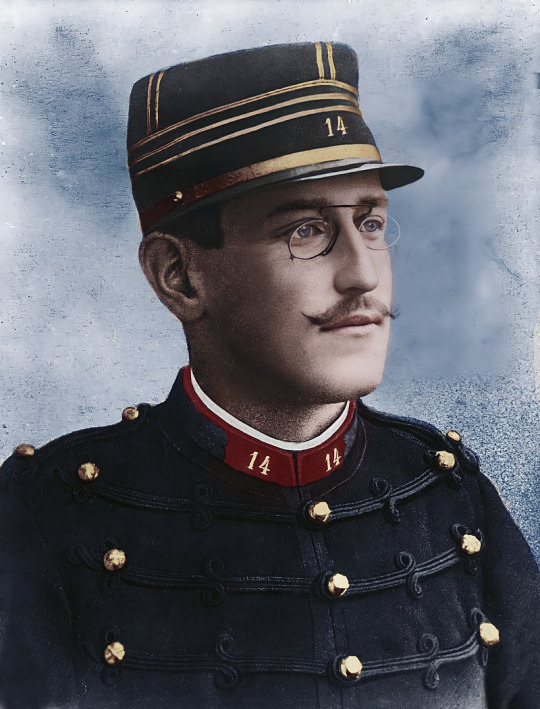
Alfred Dreyfus was a French artillery officer of Jewish ancestry from Alsace whose trial and conviction in 1894 on charges of treason became one of the most polarizing political dramas in modern French history. The incident has gone down in history as the Dreyfus affair, the reverberations from which were felt throughout Europe. It ultimately ended with Dreyfus' complete exoneration.
Born: October 9, 1859, Mulhouse
Died: July 12, 1935, Paris
Children: Pierre Dreyfus, Jeanne Dreyfus
Spouse: Lucie Dreyfus (m. 1891–1935)
Place of burial: Montparnasse Cemetery, Paris
Parents: Raphael Dreyfus, Jeannette Dreyfus
Dreyfus affair
Dreyfus affair, political crisis, beginning in 1894 and continuing through 1906, in France during the Third Republic. The controversy centred on the question of the guilt or innocence of army captain Alfred Dreyfus, who had been convicted of treason for allegedly selling military secrets to the Germans in December 1894. At first the public supported the conviction; it was willing to believe in the guilt of Dreyfus, who was Jewish. Much of the early publicity surrounding the case came from anti-Semitic groups (especially the newspaper La Libre Parole, edited by Édouard Drumont), to whom Dreyfus symbolized the supposed disloyalty of French Jews.
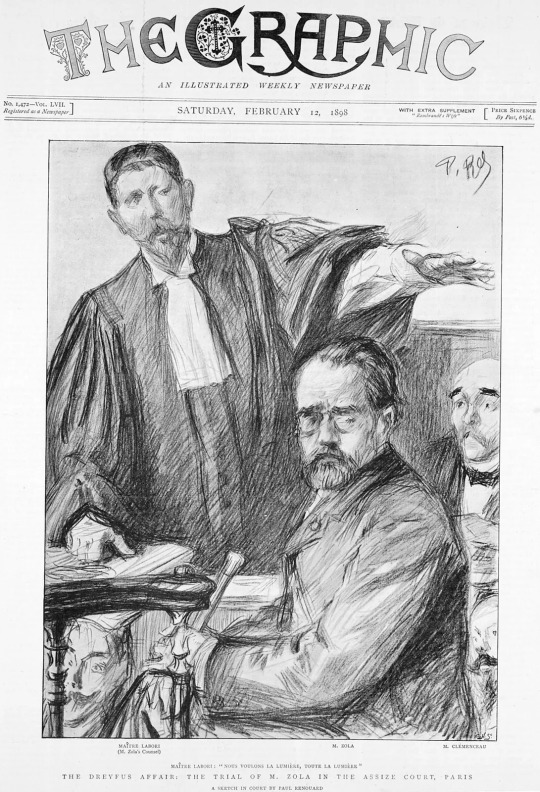
Zola, Émile: Newspaper depiction of Émile Zola in court during his trial for defamation of the French military, 1898.
The effort to reverse the sentence was at first limited to members of the Dreyfus family, but, as evidence pointing to the guilt of another French officer, Ferdinand Walsin-Esterhazy, came to light from 1896, the pro-Dreyfus side slowly gained adherents (among them journalists Joseph Reinach and Georges Clemenceau—the future World War I premier—and a senator, Auguste Scheurer-Kestner). The accusations against Esterhazy resulted in a court-martial that acquitted him of treason (January 1898). To protest against the verdict, the novelist Émile Zola wrote a letter titled “J’accuse,” published in Clemenceau’s newspaper L’Aurore. In it he attacked the army for covering up its mistaken conviction of Dreyfus, an action for which Zola was found guilty of libel.

The second court-martial of Alfred Dreyfus, illustration from Vanity Fair, Nov. 23, 1899.
By the time of the Zola letter, the Dreyfus case had attracted widespread public attention and had split France into two opposing camps. The anti-Dreyfusards (those against reopening the case) viewed the controversy as an attempt by the nation’s enemies to discredit the army and weaken France. The Dreyfusards (those seeking exoneration of Captain Dreyfus) saw the issue as the principle of the freedom of the individual subordinated to that of national security. They wanted to republicanize the army and put it under parliamentary control.

Front page of the newspaper L'Aurore, January 13, 1898, with the open letter “J'accuse” written by Émile Zola about the Dreyfus affair....(more) -From L'Aurore, January 13, 1898
From 1898 to 1899 the Dreyfusard cause gained in strength. In August 1898 an important document implicating Dreyfus was found to be a forgery. After Maj. Hubert-Joseph Henry of the intelligence section confessed to fabricating the document in order to strengthen the army’s position, revision was made almost certain. At the same time, the affair was becoming a question of vital concern to politicians. The republican parties in the Chamber of Deputies recognized that the increasingly vocal nationalist right posed a threat to the parliamentary regime. Led by the Radicals, a left-wing coalition was formed. In response to continuing disorders and demonstrations, a cabinet headed by the Radical René Waldeck-Rousseau was set up in June 1899 with the express purpose of defending the republic and with the hope of settling the judicial side of the Dreyfus case as soon as possible. When a new court-martial, held at Rennes, found Dreyfus guilty in September 1899, the president of the republic, in order to resolve the issue, pardoned him. In July 1906 a civilian court of appeals (the Cour d’Appel) set aside the judgment of the Rennes court and rehabilitated Dreyfus. The army, however, did not publicly declare his innocence until 1995.

Anti-Semitic caricature: Caricature from the anti-Semitic Viennese magazine Kikeriki. Its caption reads: “In the Dreyfus Affair, the more that is exposed, the more Judah is embarrassed.”...(more) © United States Holocaust Memorial Museum
With the Dreyfusards in the ascendant, the affair marked the start of a new phase in the history of the Third Republic, a phase in which a series of Radical-led governments pursued an anticlerical policy that culminated in the formal separation of church and state (1905). By intensifying antagonisms between right and left and by forcing individuals to choose sides, the case made a lasting impact on the consciousness of the French nation.
Félix Faure | French Republic, Politics, Legacy | Britannica
In 1894, this made the French Army's counter-intelligence section, led by Lieutenant Colonel Jean Sandherr, aware that information regarding new artillery parts was being passed to Maximilian von Schwartzkoppen, the German military attache in Paris, by a highly placed spy most likely on the General Staff. Suspicion quickly fell upon Dreyfus, who was arrested for treason on 15 October 1894.
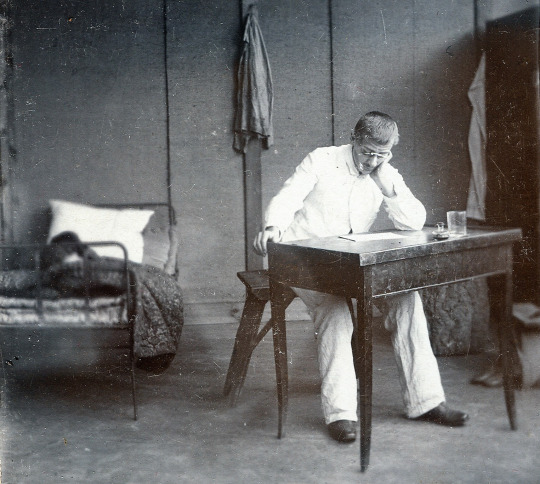
Alfred Dreyfus in his room on Devil's Island in 1898, stereoscopy sold by F. Hamel, Altona-Hamburg…; collection Fritz Lachmund
On 5 January 1895, Dreyfus was summarily convicted in a secret court martial, publicly stripped of his army rank, and sentenced to life imprisonment on Devil's Island in French Guiana. Following French military custom of the time, Dreyfus was formally degraded (cashiered) by having the rank insignia, buttons and braid cut from his uniform and his sword broken, all in the courtyard of the École Militaire before silent ranks of soldiers, while a large crowd of onlookers shouted abuse from behind railings. Dreyfus cried out: "I swear that I am innocent. I remain worthy of serving in the Army. Long live France! Long live the Army!...Continue
The affair ultimately ended with Dreyfus' complete exoneration.
Dreyfus died in Paris aged 75, on 12 July 1935, exactly 29 years after his exoneration.
Alfred Dreyfus - Wikipedia
8 notes
·
View notes
Text
MONTHLY FIC STATS UPDATE.
Did one of these in June and July so why not.
My fic is measuring at 67 pages, 31,004 words.
(there's a planning table, so some of the wordcount/half a page is that, plus titles and line breaks in each chapter.)
There are 14 chapters. The wordcount per chapter, I've been trying to even out lately, working on at least getting each chapter to at least 2000 words.
Chapter Breakdowns vs. July:
1- was 4727 words now 5347 words.
2- was 4411 words, has not changed.
3- was 2463 words, now 3005 words.
4- was 2089 words, has not changed.
5- was 1660 words, now 2026 words.
6- was 1053 words, now 1732 words.
7- was 1260 words, now 1397 words.
8- was 1094 words, now 1116 words.
9- was 898 words, now 1253 words.
10- was 1589 words, now 1708 words.
11- was 1275 words, now 1567 words.
12- was 1898 words, now 2015 words.
13- was 1338 words, now 1700 words.
14- (didn't exist yet last update), now 1145 words.
3 notes
·
View notes
Text
Saints&Reading: Saturday, August 5, 2023
august 5_july 23
THE ICON OF THE MOTHER OF GOD "JOY OF ALL SORROWING" ("WITH COINS")
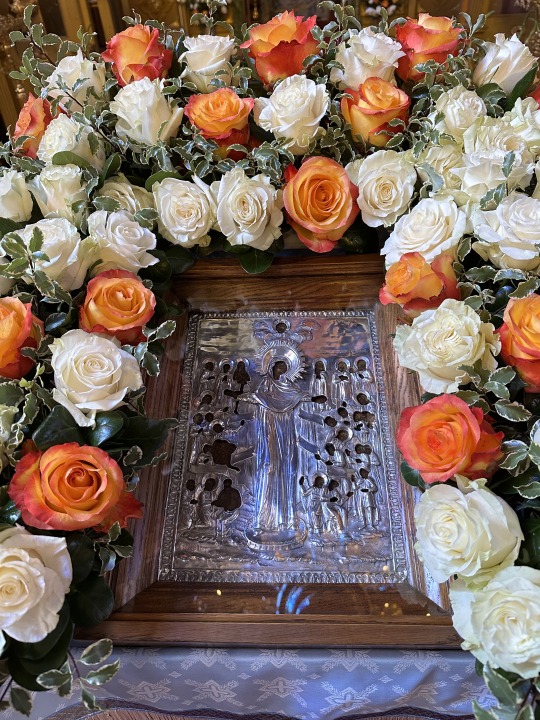
The Icon of the Mother of God “Joy of All Who Sorrow” (With Coins) was glorified in the year 1888 in St. Petersburg, when during the time of a terrible thunderstorm lightning struck in a chapel. All was burned or singed, except for this icon of the Queen of Heaven. It was knocked to the floor, and the poor box broke open at the same time. Somehow, twelve small coins (half-kopeck pieces), became attached to the icon. A church was built in 1898 on the site of the chapel.
ST JOHN CASSIAN-THE-ROMAN (435)

The Monk John Cassian the Roman, as to the place of birth and the language in which he wrote – belonged to the West, but the spiritual native land of the saint was always the Orthodox East. John accepted monasticism at a Bethlehem monastery situated at a place not far from where the Saviour was born. After a two-year stay at the monastery, in the year 390 the monk with his spiritual brother Germanus journeyed over the course of seven years through the Thebaid and Skete wilderness monasteries, drawing upon the spiritual experience of innumerable ascetics. Having returned in 397 for a brief while to Bethlehem, the spiritual brothers were ascetics for three years in complete solitude, but then they set out to Constantinople, where they attended to Sainted John Chrysostom.
Cassian was ordained to the dignity of presbyter in his own native land. At Massilia (Marseilles) in Gallia (Gaul, now France) he first established there two coenobitic (life-in-common) monasteries, a men’s and a women’s, on the order of monastic rules of Eastern monasticism. At the request of Bishop Castor of Aptia Julia (in Gallia Narbonensis), the Monk Cassian in the years 417-419 wrote 12 books entitled “De Institutis Coenobiorum” (“On the Directives of Coenobitic Life”) from the Palestinian and Egyptian monks and including 10 conversations with the desert fathers, to provide his fellow countrymen examples of life in common (cenobitic) monasteries and acquaint them with the spirit of the asceticism of the Orthodox East. In the first book of “De Institutis Coenobiorum” the talk concerns the external appearance of the monastic; in the second – pertaining to the order of the night psalms and prayers; in the third – concerns the order of the daytime prayers and psalms; in the fourth – concerning the declaration of renunciation from the world; in the eight remaining books – concerning eight chief sins.
In the conversations of the fathers, Saint Cassian as a guide within asceticism, speaks about the purpose of life, spiritual discernment, the degrees of renunciation from the world, the passions of the flesh and spirit, the eight sins, the hardship of the righteous, and about prayer.
In the years following, the St. Cassian described another fourteen (or else twenty-four) “Conversations of the Fathers” (the “Collationes Patrum”): about the perfection of love, purity, the help of God, the comprehending of Scripture, the gifts of God, about friendship, about the use of language, about the four levels of monasticism, about solitary hermetic life and coenobitic life-in-common, about repentance, about fasting, about nightly meditations, about spiritual mortification – this last given the explanatory title “I want not to, yet this I do”.
In the year 431, Saint John Cassian wrote his final work, “Against Nestorius” (“De incarnation em Domini contra Nestorium” – literally “On the Incarnation of the Lord, against Nestorius”). In it, he gathered against the heresy opinions of censure of many Eastern and Western teachers. In his works, the St. John Cassian grounded himself in the spiritual experience of the ascetics, meriting the admiration of Blessed Augustine (Comm. 15 June), that “grace far least of all is defensible by pompous words and loquacious contention, by dialectic syllogisms and the eloquence of a Cicero”. In the words of St. John of the Ladder, “Great Cassian discerns loftily and quite excellently”. Saint John Cassian, the Roman, reposed peacefully in the year 435.

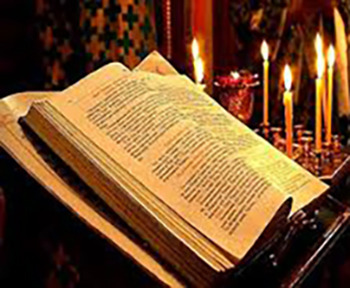
HEBREWS 9:1-7
1 Then, indeed, even the first covenant had ordinances of divine service. An earthly sanctuary. 2 For a tabernacle was prepared: the first part, in which was the lampstand, the table, and the showbread, which is called the sanctuary; 3 and behind the second veil, the part of the tabernacle which is called the Holiest of All, 4 which had the golden censer and the ark of the covenant overlaid on all sides with gold, in which were the golden pot that had the manna, Aaron's rod that budded, and the tablets of the covenant; 5 and above it were the cherubim of glory overshadowing the mercy seat. Of these things, we cannot now speak in detail. 6 When these things had been thus prepared, the priests always went into the first part of the tabernacle, performing the services. 7 But into the second part the high priest went alone once a year, not without blood, which he offered for himself and for the people's sins committed in ignorance;
LUKE 10:38-42; 11:27-28
38 Now it happened as they went that He entered a certain village; and a certain woman named Martha welcomed Him into her house. 39 And she had a sister called Mary, who also sat at Jesus' feet and heard His word. 40 But Martha was distracted with much serving, and she approached Him and said, "Lord, do You not care that my sister has left me to serve alone? Therefore tell her to help me." 41 And Jesus answered and said to her, "Martha, Martha, you are worried and troubled about many things. 42 But one thing is needed, and Mary has chosen that good part, which will not be taken away from her. 27 And it happened, as He spoke these things, that a certain woman from the crowd raised her voice and said to Him, "Blessed is the womb that bore You, and the breasts which nursed You!" 28 But He said, "More than that, blessed are those who hear the word of God and keep it!"
#orthodoxy#orthodoxchristianity#easternorthodoxchurch#originofchristianity#spirituality#holyscriptures#bible#gospel#wisdom#icon#sacredart#saints
13 notes
·
View notes
Text
Guardians of Freedom: The Stories of Philippines National Heroes
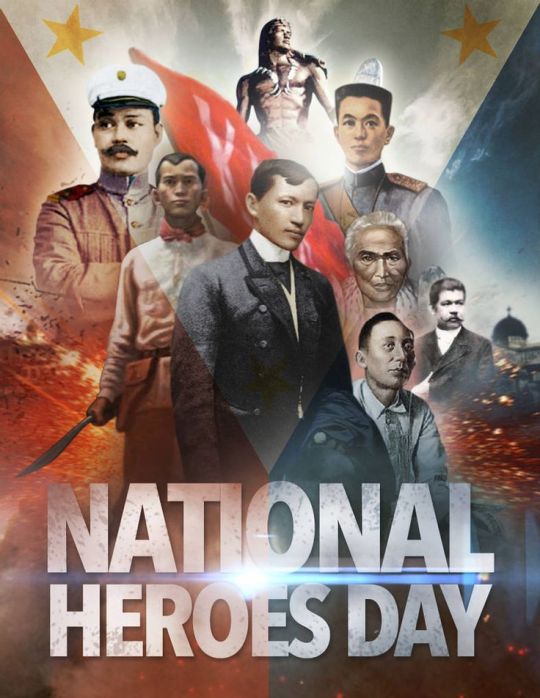
In the Philippines, national heroes are revered figures who have significantly contributed to the country's history, Independence, and cultural development. Here are some prominent national heroes along with thei contributions and courage:
1. Dr. Jose Rizal: Known as the national hero of the Philippines, Dr. Jose Rizal was an opthalmologist, writer, and revolutionary. His novels, "Noli Me Tangere" and "El Filibusterismo", criticized Spanish colonial rule and called for reforms, inspiring the movement for Philippine Independence. His martyrdom in 1896 sparked a nationwide uprising against Spanish colonization.
2. Andres Bonifacio: A key figure in the Philippine Revolution, Andres Bonifacio was the founder of the Katipunan, a revolutionary society that aimed to overthrow Spanish rule. His leadership and bravery in mobilizing the Filipino people to fight for freedom were instrumental in the fight for Independence. He is known for his decisive and courageous actions.
3. Emilio Aguinaldo: Emilio Aguinaldo was a military leader and the first president of the Philippines. He played a crucial role in the Philippine Revolution against Spain and later in the Philippine-American War. Aguinaldo declared Philippine Independence on June 12, 1898, marking country's assertion of sovereignty.
4. Melchora Aquino ( Tandang Sora): Known as the " Mother of the Katipunan", Melchora Aquino provided support to the revolutionaries during the Philippine Revolution. Her courage and commitment to the cause made her a symbol of maternal strength and patriotism.
5. Gabriela Silang: A revolutionary leader and the first female revolutionary leader in Philippines history. Gabriela Silang continued the resistance against Spanish rule after her husband, Diego Silang, was assassinated. Her leadership and bravery made her a notable figure in the fight for Independence.
6. Apolinario Mabini: Known as the " Sublime Paralytic", Apolinario was a key advisor to Emilio Aguinaldo and a revolutionary thinker. Despite his physical limitations, he played a pivotal role in the Philippine Revolution and the early days of the Philippine Republic.
7. Diego Silang: He was a revolutionary leader in Ilocos region during the 18th century. He is best known for leading the Ilocano revolt against the Spanish authorities, known as the Silang Revolt. Diego Silang's revolt was driven by opposition to the oppressive Spanish policies, including high taxes, forced labor, and abuses by local officials.
In 1762, during the British occupation of Manila, Diego Silang saw an opportunity to push for Ilocano Independence. He declared the Independence of Ilocos from Spanish rule and established the "Free Ilocos" advocating for self-governance and autonomy. Silang's bravery and charismatic leadership inspired many Ilocanos to join his cause. Unfortunately, his rebellion was short-lived. He was assassinated in 1763 by a trusted companion, Miguel Vicos, who was bribed by the Spanish. Despite his untimely death, Diego Silang's legacy of resistance and courage continued to inspire other revolutionaries, including his wife, Gabriela Silang, who took up the cause after his assassination.
These heroes, among others, are celebrated for their significant contributions to the country's history, their courage in the face of adversity, and their enduring legacy in the fight for Philippine Independence and national Identity. Each hero's life and story reflect the broader struggle for freedom, justice and national pride.
Thank you for reading. Until next time, salamat and see you soon!

2 notes
·
View notes
Text
Holidays 6.12
Holidays
Anne Frank Day
Bedstraw Day (French Republic)
Blue Galaxy Day
Children’s Day (Haiti)
Crowded Nest Syndrome Day
Dia dos Namorados (Brazil)
Flag Day (Brazil; New Zealand)
Ghost in the Machine Day
Grimace Day
Helsinki Day (Finland)
Idol Day
Indiana Jones Day
International Adobo Day
International DDX3X Day
International Dubbing Day
International Shia Day
Interracial Marriage Day
June 12 Commemoration (Lagos State, Nigeria)
Lancaster Day (UK)
Little League Girls Baseball Day
Lover’s Day (Japan)
Loving Day
Magic Day
Man of Steel Day
Mother’s Day (Luxembourg)
National Automotive Service Professionals Day
National Black Men Don’t Cheat Day
National Button Battery Awareness Day
National Cancer Thriver Day
National Chiropractic Health Assistant Day (Canada)
National Control Room Worker’s Day
National Cougar Day
National Dairy Goat Awareness Day
National Dame Day
National Esther Day
National Great Dane Day
National Harm Reduction Day (Canada)
National Hospital at Home Patients Day
National Magic Day
National X Day
Orlando United Day (Florida)
Peace Day (Kosovo)
Perfect Game Day
Portland Trail Blazers Day (Oregon)
Pulse Remembrance Day
Queen’s Birthday (Pitcairn Islands, Tuvalu)
Railway Day (Japan)
Red Rose Day
Rock Around the Clock Day
Russia Day (Russia)
Science Day (Turkmenistan)
Senior Race Day (Isle of Man)
Sharon Needles Day (Pittsburgh, Pennsylvania)
612 Day (Minnesota)
Spoonful of Sugar Day
Spousal Abuse Day
State Protection Service Day (Poland)
Stock Market Employees Day (Ukraine)
Superman Day
Swiss Army Knife Day
Tear Down This Wall Day
Valentine’s Day (Brazil)
Welsh Bands T-Shirt Day (UK)
We Remember 612 Day (Hong Kong)
Women’s Veterans Day
World Day Against Child Labour (UN)
Food & Drink Celebrations
Chuy’s National Taco Day
International Cachaca Day
International Falafel Day
National Apple Cinnamon Muffin Day
National Jerky Day
Peanut Butter Cookie Day
Pink Spaghetti Day
Poultry Day
Independence & Related Days
Act of Settlement Day (UK; 1701)
Bill of Rights Day (Virginia; 1776)
Chaco Armistice Day (Paraguay)
Constitution Day (Turks & Caicos Island)
Democracy Day (Nigeria)
Philippines (from Spain, 1898)
2nd Wednesday in June
National Time Out Day [2nd Wednesday]
Worshipful Company of Vintners of the City of London Annual Procession [2nd Wednesday]
Weekly Holidays beginning June 12 (2nd Full Week)
California State Parks Week (thru 6.16)
International Listening Association Week (thru 6.16)
Raggedy Ann and Andy Days (thru 6.13)
Festivals Beginning June 12, 2024
Emmett Cherry Festival (Emmett, Idaho) [thru 6.15]
Ice Cream Days (Le Mars, Iowa) [thru 6.15]
Mattituck Strawberry Festival (Mattituck, New York) [thru 6.16]
North by Northeast [NXNE] (Toronto, Canada) [thru 6.16]
San Diego County Fair (Del Mar, California) [thru 7.7]
Taste of London (London, UK) [thru 6.16]
Teapot Day (Tea, South Dakota) [thru 6.15]
W. C. Handy Blues & Barbecue Festival (Henderson, Kentucky) [thru 6.15]
Feast Days
Adriaen van Stalbemt (Artology)
St. Anthony’s Day Eve (Portugal)
Antonina (Christian; Martyr)
Bannocks Day (Celtic Book of Days)
Basilides, Cyrinus, Nabor and Nazarius (Christian; Martyrs)
Be More Paranoid Day (Pastafarian)
Bob Katz (Muppetism)
St. Charles Borromeo (Positivist; Saint)
Dave Berg (Artology)
Egon Schiele (Artology)
Enmegahbowh (Episcopal Church)
Eskil of Sweden (Christian; Martyr)
Feast of the Blessed Polish Martyrs of World War II
Festival of Mut (Ancient Egypt)
First Ecumenical Council (Lutheran)
Gaspar Bertoni (Christian; Saint)
Gerard Hoffnung Day (Church of the SubGenius; Saint)
Gin Day (Pastafarian)
Guy of Cortona (Christian; Saint)
Henry Scott Tuke (Artology)
Hildegard Burjan (Christian; Blessed)
Johanna Spyri (Writerism)
John of Sahagún (Christian; Saint)
Korean Rice Farmers Stream Hair Washing Day (Everyday Wicca)
Len Wein (Artology)
Leo III, Pope (Christian; Saint)
Media Ver VII (Pagan)
Odulf (Christian; Saint)
Onuphrius (Christian; Saint)
Peter of Mount Athos (Christian; Saint)
Sparky Day (Church of the SubGenius; Saint)
Ternan, Bishop of the Picts (Christian; Saint)
Zeus’ Day (Ancient Greece)
108 Martyrs of World War II (Christian)
Hebrew Calendar Holidays [Begins at Sundown Day Before]
Shavuot, Day 2 (Judaism) [6-7 Sivan] (a.k.a. …
Feast of the Harvest
Feast of Weeks
Festival of Weeks
First-Fruit festival
Wheat Harvest
Lucky & Unlucky Days
Prime Number Day: 163 [38 of 72]
Taian (大安 Japan) [Lucky all day.]
Unfortunate Day (Pagan) [34 of 57]
Premieres
Admission Free (Betty Boop Cartoon; 1932)
All About Dogs (Terrytoons Cartoon; 1942)
Andy Warhol’s Blue Movie (a.k.a. Fuck; Adult Film; 1969)
Are You My Mother?, by P.D. Eastman (Children’s Book; 1960)
The Brighter Buccaneer, by Leslie Charteris (Short Stories; 1933) [Saint #12]
Bullet Park, by John Cheever (Novel; 1969)
Can’t Hardly Wait (Film; 1998)
Chesapeake, by James A. Michener (Historical Novel; 1978)
Chuck Berry Is On Top, by Chuck Berry (Album; 1959)
Clash of the Titans (Film; 1981)
Cleopatra (Film; 1963)
Clockwork Angels, by Rush (Album; 2012)
Coming Up for Air, by George Orwell (Novel; 1939)
Deep Throat (Adult Film; 1972)
Donald’s Garden (Disney Cartoon; 1942)
Donovan’s Reef (Film; 1963)
Farmer Al Falfa’s Bedtime Story (Terrytoons Cartoon; 1932)
Food, Inc. (Documentary Film; 2009)
Foundation and Empire, by Isaac Asimov (Novel; 1952) [Foundation #2]
Go Bo Diddly, by Bo Diddly (Album; 1959)
History of the World: Part 1 (Film; 1981)
The Horse Soldiers (Film; 1959)
I’ll Chase the Blues Away, recorded by Ella Fitzgerald (Song; 1935)
The Immortal Life of Henrietta Lacks, by Rebecca Skloot (Science Book; 2010)
Jurassic World (Film; 2015)
Line of Duty (BBC TV Series; 2012)
Love and Kisses, recorded by Ella Fitzgerald (Song; 1935)
Mariah Carey, by Mariah Carey (Album; 1990)
Me and Earl and the Dying Girl (Film; 2015)
Moon (Film; 2009)
Palestrina, by Hans Pfitzner (Opera; 1917)
Predator (Film; 1987)
Raiders of the Lost Ark (Film; 1981)
Rhapsody in Blue, by George Gershwin (Orchestral Jazz; 1924)
The Sailor’s Home (Terrytoons Cartoon; 1936)
She’s Not There, recorded by The Zombies (Song; 1964)
Some Time in New York City, by John Lennon (Album; 1972)
Speedway (Film; 1968)
Superman vs. The Elite (Animated WB Film; 2012)
Surfer Girl, recorded by The Beach Boys (Song; 1963)
Swingers (Film; 1997)
Take Off Your Pants and Jacket, by Blink-182 (Album; 2001)
Testimony of Two Men, by Taylor Caldwell (Novel; 1968)
Toreadorable (Fleischer/Famous Popeye Cartoon; 1953)
2 Cool 4 Skool, by BTS (Album; 2013)
The Witches of Eastwick (Film; 1987)
Today’s Name Days
Florinda, Guido, Leo (Austria)
Bazilid, Gašpar, Leon (Croatia)
Antonie (Czech Republic)
Balisius (Denmark)
Eskel, Esko (Estonia)
Esko (Finland)
Guy (France)
Florinda, Guido, Leo (Germany)
Onoufrios (Greece)
Villő (Hungary)
Basilide, Guido, Onofrio (Italy)
Ija, Narda, Nora (Latvia)
Anupras, Dovė, Kristijonas, Kristis, Ramūnas (Lithuania)
Sigfrid, Sigrid, Siri (Norway)
Antonina, Bazyli, Jan, Leon, Onufry, Wyszemir (Poland)
Onufrie, Pavel, Petru (România)
Zlatko (Slovakia)
Juan, Onofre (Spain)
Eskil (Sweden)
Onopriy (Ukraine)
Ahmad, Ahmed, Aisha, Asia, Mohamed, Mohammad, Mohammed (USA)
Today is Also…
Day of Year: Day 164 of 2024; 202 days remaining in the year
ISO: Day 3 of week 24 of 2024
Celtic Tree Calendar: Duir (Oak) [Day 4 of 28]
Chinese: Month 5 (Geng-Wu), Day 7 (Ding-Wei)
Chinese Year of the: Dragon 4722 (until January 29, 2025) [Wu-Chen]
Hebrew: 6 Sivan 5784
Islamic: 5 Dhu al-Hijjah 1445
J Cal: 14 Blue; Sevenday [14 of 30]
Julian: 30 May 2024
Moon: 36%: Waxing Crescent
Positivist: 23 St. Paul (6th Month) [St. Charles Borromeo]
Runic Half Month: Dag (Day) [Day 4 of 15]
Season: Spring (Day 86 of 92)
Week: 2nd Full Week of June)
Zodiac: Gemini (Day 23 of 31)
1 note
·
View note
Text
Mystery of Frances Appleton Packard
This past June I wrote about the importance of LGBTQ+ ancestors, stating that there are more queer ancestors within my family tree, and pointed out my fourth cousin five times removed, Frances Appleton Packard (1836-1902), noting that she "was always listed as single and never noted as marrying anyone, which can be a clue that the person is a queer individual". [1] In this post, I'd like to focus on her life.
Reprinted from my Packed with Packards! WordPress.
Frances was born in Brunswick, a town within Cumberland County, Maine on March 28, 1836 to Alpheus Spring Packard, Sr., a professor of Greek and Latin at Bowdoin College, and Frances Elizabeth Appleton, said to be a "woman of rare excellence". Unfortunately, when Frances A. was three years old, her mother would die for reasons not yet known. Frances A. next appears in the 1850 census, living with her father, Alpheus Sr., her five brothers (Charles A., William A., George L., Alpheus Jr., Robert L.), her stepmother Caroline W. Bartels (Alpheus Sr.'s second wife), and two boarders: 12-year-old George McLellan and 17-year-old Joanna Sillers. By 1860, however, she would not be living in the same household as her parents. Where she was living that year remains a mystery. But, one can make the supposition that she was still living in Brunswick, as she was living with her family in 1870 with her father and stepmother. This would be unchanged by 1880, as she still lived in Brunswick with her parents and an 18-year-old servant named Margaret Cusick in the household. [2]
Further evidence of her residence in Brunswick is made clear by one document: the school catalogue of Abbott Female Academy. She attended there between 1851 and 1852. She was among many married women, many of whom were from towns in New England or elsewhere. Abbott Academy, based in Andover, Massachusetts, was a well-known independent boarding prep school which was aimed at educating young women, with women proving key to its success, and was beginning to develop its robust curriculum. She would not be a student there the following term, from 1852 to 1853. She would only be briefly mentioned elsewhere, and additional records show that she was living in Bath, Maine (first on 21 Linden and later on 894 Washington), through the 1890s and into the early 1900s. In these records, she is never noted as marrying anyone else, always shown noted as being unmarried. [3] She would die on July 20, 1902 in Bath from bronchitis pneumonia and be noted as a housekeeper:
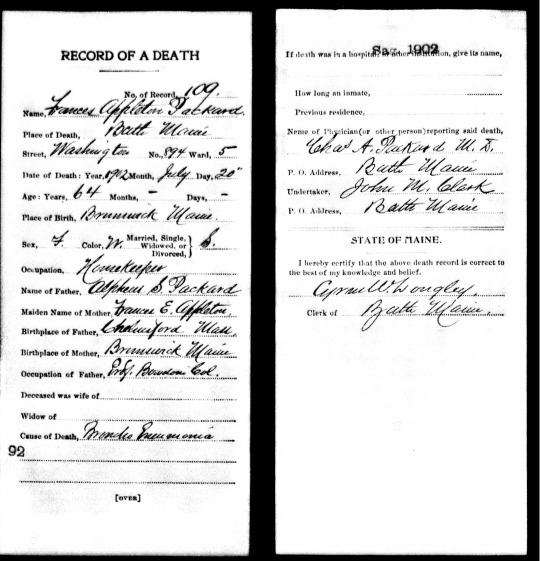
This image combines records from Maine, U.S., Death Records, 1761-1922 for Frances Appleton Packard, 1902, P, Maine State Archives; Cultural Building, 84 State House Station, Augusta, ME 04333-0084; 1892-1907 Vital Records; Roll Number: 43, Images 1-2. Charles, her brother, is noted as providing information about her.
She would be buried in Pine Grove Cemetery alongside her parents. Her Find A Grave entry only says two words currently: "Never married." [4] There's much more that can be said about her, however. A search on newspapers.com uncovered an obituary in the Sun-Journal which described her as a "woman of culture", a "deep student of literature" and member of the Fortnightly club. It also notes that she lived in Brunswick from her birth, in 1836 until the death of her father in 1884, and then moved to Bath, where she lived, meeting "many warm-hearted friends" which he kept until her death. It further notes her membership in the Congregational Church of Brunswick and later in the Winter street church in Bath. She was noted as dying, at the age of 63, at the home of her brother Charles who lived in Bath as well. Other notices pointed out that William, the sister of Frances, would administer his estate. [5]
We also learn, from the newspapers, that Frances visited the Bath Military and Naval Orphan Asylum in February 1898, where it turns out she worked as a "lady visitor" since at least January 1895. She is not to be confused with Frances Elizabeth Packard (1880-1971), daughter of Alpheus Jr. (Frances A.'s brother) and Elizabeth Derby Walcott who was said to be a "remarkably interesting young woman" who went on a trip to Europe, Asia, and Africa, from 1898 to 1899, and reportedly had "many friends" in Auburn and Lewiston. As for Frances A., one article confirmed her trip to Liverpool in 1899. She was clearly more than someone who was unmarried whose nickname was purportedly "Fanny", but a person who had a full life. [6]
The Bath Military and Naval Orphan Asylum was a place that helped out soldiers' orphans, and "half orphans of officers, soldiers, seamen and marines" who died while in combat or from wounds, injuries, or disease. This may be why Frances A. was listed as a housekeeper on her death record. It also included soldiers’ and sailor’s orphan children and grandchildren of any gender, specifically veterans of the Civil War. By January 1903, there were 69 children in the asylum plus 18 who were admitted and 25 taken in by other homes or relatives. Some children had been "farmed to outside homes" but came back to the asylum for "one reason or another".
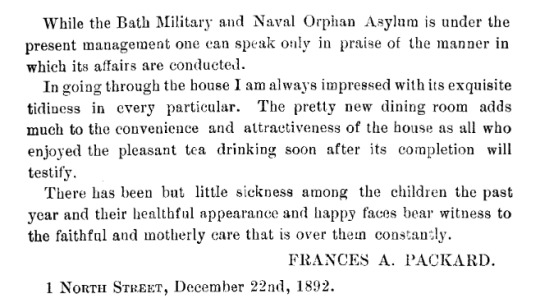
In 1892, Frances A. voices her views on the aforementioned asylum in 1892 and shows that she is impressed by it [7]
In sum, much of the life of Frances Appleton Packard remains a mystery, complicated by the fact there were others who had similar names, leading to a propensity of false drops. Additionally, while she was noted as single throughout her life, I could find no indication that she ever had a partner. The supposition, based on what I said at the beginning of this post, that those listed as single may be queer is still a good one, but in the case of Frances A., all we can say is that she was single and unmarried throughout her life, as no evidence points to anything else. After all, thought her life, Maine had in place a sodomy law which imprisoned people for ten years, after a revision in 1840, for the crime of sodomy (anal sex, oral sex, or bestiality), laws which are usually used against gay or lesbian people. It would only be repealed in 1976. Even so, some have said that Maine has a "rich LGBT history that is relatively unknown". Interestingly, Brunswick is among the towns recommended for where LGBTQ people should move, while Bath is not. The exact history of LGBTQ people in those towns is still fuzzy, although one source said that "rural Maine gays who had little support in their small towns." That was likely the case for Brunswick and Bath, perhaps more for the latter than the former. [8] In sum, the story of Frances A., living in a town based in shipbuilding (Bath) and the center of activity for the Pejepscot region (Brunswick) remains unwritten, but this article is just the start.
© 2023 Burkely Hermann. All rights reserved.
Notes
[1] There are other ancestors that I believe might be gay or otherwise queer, since they never married: my great-granduncles Harold "Harry" Cyrus Packard (1907-1975), Herbert Miles Packard (1898-1966), and Thomas "Tom" Theodore Packard (1902-1975) (this would be funny as he was apparently staunchly Republican), my great-grandaunts Olive Martha Packard (1896-1969) and Rachel May Packard (1900-1933), my second great-uncle Joseph B. Mills (1844-1900), my first cousin two times removed Giles Franklin Whitley (1911-1970) who died in 1970. The same is the case for my great-granduncle Joseph Winfield Packard (1885-1910), but that is no surprise as he only lived to the age of 24 before a freight train took his life. The same is the case for my first cousin three times removed Harry Tilson Packard (1879-1915), my first cousin three times removed, who died at the age of 36 in Los Angeles, and my second great aunt Mary M. Packard (1862-1887) who died at only 24 years old. I also have a nonbinary cousin, whose name I won't mention here, and on that note, I'd love to find some nonbinary ancestors, although that could be a challenge. There's also the interesting fact that my second great-grandaunt Margaret "Maggie" E. Mills (1854-1920) and father of great-grandaunt Thomas H. Crosgrove (b. 1858) only had a child when they adopted Mabel Hattie Packard (1892-1961), my great-grandaunt who is the child of Cyrus Winfield Packard (1852-1924) and Dorothy "Dora" Ann Mills (1849-1895), adopted by Thomas and Mabel at age 3. Also, Mary Jane Mills (b. 1854) my 2nd great-grand aunt was not married, from the little we know about her, nor was my second great-grand uncle, William Mills (b. 1861), my first cousin three times removed, Joseph Arthur Packard (1891-1911) who died at age 20, my first cousin three times removed, Walter Archie Packard (1903-1928) who died at age 25 when he was crushed by an elevator in the Montgomery Ward building in Albany. Additionally, my second great-granduncle B. Fred "Freddie" Packard (1858-1884) never married, nor did my first cousin four times removed Eva L. Packard (1876-1967), living in Kansas City for over 50 years, my first cousin four times removed Martha Elvira Packard (1880-1957), living in Kansas City like her sister Eva. The same is the case for my fourth great-grandaunt Ruby Packard (1799-1871) who never married and died of old age or my fourth great-grandaunt Sally Packard (1792-1868). Also, my first cousin three times removed Ida Martha Packard (1892-1973) and her husband Andrew Erastus Kenney (1891-1971) never had any children. Then there's Polly Nash Packard (1819-1868), my third great-grandaunt, termed to have a mental illness by censustakers and stayed at home for her whole life.
[2] 1850 United States Federal Census for Frances A Packard, Maine, Cumberland, Brunswick, Year: 1850; Census Place: Brunswick, Cumberland, Maine; Roll: 251; Page: 254b; 1860 United States Federal Census for Alpheus S Packard, Maine, Cumberland, Brunswick, Year: 1860; Census Place: Brunswick, Cumberland, Maine; Roll: M653_437; Page: 58; Family History Library Film: 803437; 1870 United States Federal Census for Frances A Packard, Maine, Cumberland, Brunswick, Year: 1870; Census Place: Brunswick, Cumberland, Maine; Roll: M593_539; Page: 75A; 1880 United States Federal Census for Francis A. Packard, Maine, Cumberland, Brunswick, 024, Year: 1880; Census Place: Brunswick, Cumberland, Maine; Roll: 477; Page: 55C; Enumeration District: 024. I went through all 120 pages of the 1860 United States Federal Census for Brunswick and didn't see anyone who was Frances. Interestingly, there is a family led by a 45-year-old John Mills and 30-year-old Mary Mills on image 80 (of 120).
[3] U.S., College Student Lists, 1763-1924 for Frances A Packard, Massachusetts, Abbott Female Academy, 1879 (date of publication), Image 174 (and page 48); U.S., College Student Lists, 1763-1924, Massachusetts, Abbott Female Academy, 1879 (date of publication), Image 176; https://archive.org/details/memorialalpheuss00litt/page/10/mode/2up (on page 10); U.S., City Directories, 1822-1995 for Frances A Packard, Maine, Bath, 1897, Bath, Maine, City Directory, 1897, Image 134 (Page 131); Boston, Massachusetts, U.S., Book Indexes to Passenger Lists, 1899-1940, (002) Aug. 26, 1899-June 30, 1900, National Archives and Records Administration (NARA); Washington, D.C.; Book Indexes to Boston Passenger Lists, 1899-1940; Microfilm Serial: T790; Microfilm Roll: 2, Image 148; U.S., City Directories, 1822-1995 for Frances A Packard, Maine, Bath, 1902, Bath, Maine, City Directory, 1902, Image 83 (page 161).
[4] Maine, U.S., Nathan Hale Cemetery Collection, 1780-1980 for Frances Packard Appleton, Annis, George F-Austin, John B, Images 194 and 1035.
[5] "Obituary of Miss Frances Appleton Packard, dying at home of her brother, Charles" clip from Sun-Journal, Lewiston, Maine, 21 Jul 1902, Page 7; "Death notices" clip from Kennebec Journal, Augusta, Maine, 30 Jul 1902, Page 5; "William A. Packard is administrator of his sister's estate" clip from Kennebec Journal, Augusta, Maine, 05 Dec 1902, Page 2. She wasn't mentioned in her father's obituary in 1884 weirdly enough.
[6] She is mentioned as a lady visitor at the asylum on page 5 of this report. Also, the "Appleton-Aiken family papers (1806-1934)" Finding Aid put together by the University of Michigan Clements Library, she is listed as unmarried. Also see: "Frances visits the home" clip from Sun-Journal, Lewiston, Maine, 26 Feb 1898, Page 18; "Frances elected as a "lady visitor"" clip from The Lewiston Daily Sun, Lewiston, Maine, 08 Jan 1895, Page 6; "Passengers return from Liverpool" clip from Boston Evening Transcript, Boston, Massachusetts, 23 Sep 1899, Page 4. This article is about the other Frances: "Frances returns from a trip abroad" clip from Sun-Journal, Lewiston, Maine, 14 Oct 1899, Page 8. This Frances was covered in the newspaper more, as in 1901, it was noted that Florence Gallagher, Elise P. Packard, and Jessy L. McClellan, all women who seemed to be unmarried, were Frances' guests at the Mere Point House (see "Frances entertains guests at Mere Point House" clip from Sun-Journal, Lewiston, Maine, 20 Jul 1901, Page 12). It was also shown that this Frances had been to other parties at the house, including one sailed by a Mr. Packard (see "Frances presents a gift" clip from Sun-Journal, Lewiston, Maine, 02 Aug 1895, Page 8; "Opens cottage at Mere Point" clip in Sun-Journal, Lewiston, Maine, 25 Jun 1901, Page 3). This Frances also seemed to be supportive of temperance (see "Elected to temperance temple" clip in Sun-Journal, Lewiston, Maine, 15 Jan 1898, Page 6). This Frances purportedly crossed the Atlantic with Alpheus Jr. during his travels (see page 200 of T.D.A. Cockerwell's Biographical Memoir of Alpheus Spring Packard 1838-1905). She is also not to be confused with the daughter of William Alfred Packard (Frances E's brother) and Susan Breeze Gallagher also named Frances Appleton Packard (born c. 1865) who died at the age of 17 in October 1882.
[7] Twenty-Second Annual Report of the Military and Naval Asylum At Bath, ME. 1892 (Augusta: Burleigh & Flynt, 1892), 8.
[8] Alan Woods in his "The 7 Best Towns in Maine for LGBT Families" article recommends Augusta, Bangor, Bar Harbor, Brunswick, Ogunquit, Portland, and Rockland. Also see "Pride Maine LGBT History: Life and Activism in the 1970s, a panel discussion and exhibit", "Maine LGBT History: Life & Activism in the 70s. Part One", "LGBTQ+ History in Maine: A Documentary History Reader", "LGBT History in Maine 1856-1984", "Great Towns for LGBT Couples in Maine", "Bath library celebrates pride month, marks LGBTQ+ history in Maine".
#lgbtq#packard#ancestors#genealogy#ancestry#family history#genealogists#family tree#housekeepers#asylums#queer community#queer history
3 notes
·
View notes
Text


Wallace Ford (February 12, 1898 – June 11, 1966)
5 notes
·
View notes